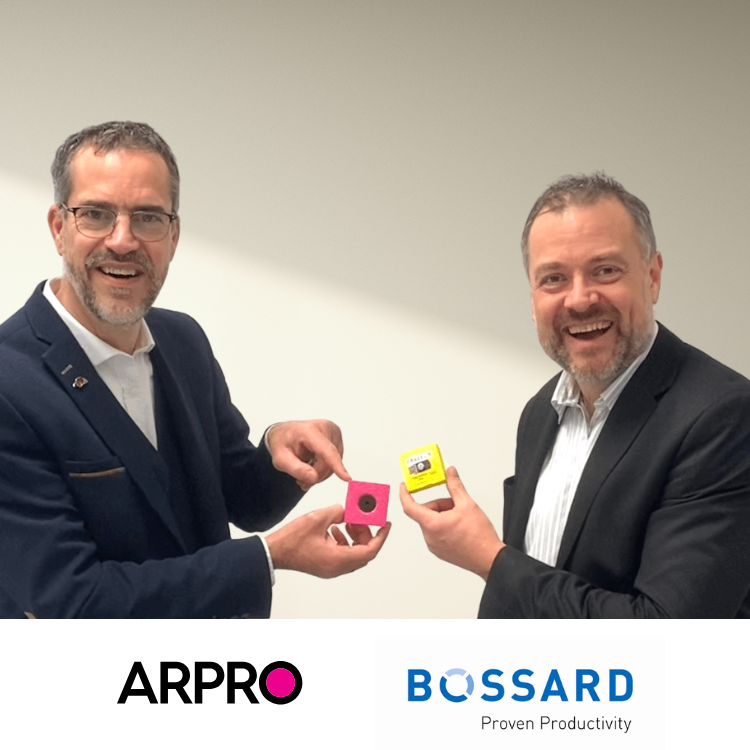Publication date: 01.04.2025
Component and Fastening Solution Made from the Same Recyclable Material
Being Sustainable is Possible With ARPRO from JSP and Bossard Germany with MM-Welding® Technology

The focus is on the circular economy. The European Parliament is set to discuss and adopt the regulation for vehicle recycling shortly, which includes a specific "recycled content" requirement. The current plan mandates that 25% of the plastic used to build a new vehicle must come from recycling, with 25% of that material sourced from end-of-life vehicles.
JSP, the global market leader in the EPP sector (expanded polypropylene particle foam materials), does not intend to wait for the regulation or settle for just 25%. JSP already supplies its 100% recyclable EPP foam, ARPRO, for a wide range of applications across various industries.
The future of sustainability has already begun. For 15 years, JSP has been offering customers a certified sustainable product with 30% or even up to 90% recycled content as standard. And for fastening and connections, JSP relies on its trusted partner, Bossard. In an interview, Bert Suffis, Sales & Innovation Director at JSP, and Christian Busch, Business Development Manager at Bossard Germany, discuss the background, milestones, and new plans for their collaboration.
Mr. Suffis, let’s start with a direct question: Why JSP and Bossard, and not JSP and Company XY?
Bert Suffis: Both companies have a strong focus on business development. This means our partnership offers significant added value for customers. While JSP supplies ARPRO to industries such as automotive, HVAC, building and ventilation technology, construction, and packaging, Bossard Germany provides MM-Welding® technology for the rapid and strong bonding and functionalisation of EPP foam using ultrasonic technology.
But particle foam components also need to be connected, and fasteners or threads must be integrated.
Christian Busch: And this is exactly where Bossard comes in. With LiteWWeight® zEPP, we offer the ideal complement for these components. Using an innovative process based on ultrasonic technology, additional functions can be quickly and securely integrated into the particle foam components. The plastics used meet the standard injection moulding requirements.
So Bossard and JSP became partners?
Bert Suffis: Exactly. Bossard Germany and JSP have been working together as partners for five years now. At its Innovation Centre in Düsseldorf, JSP even demonstrates a special "ultrasonic" system, showcasing firsthand the advantages of combining ARPRO with MM-Welding® technology.
Christian Busch: The partnership brings reduced costs, accelerates assembly, improves products, and expands design freedom. For us, strengthening the strategic partnership between our companies not only generates innovative potential for the future but also creates real benefits for customers today. They can be confident that they are getting not only the best possible material for their applications but also the perfect solution for fastening and joining it as needed.
Bert Suffis: Another key point is that both Bossard and JSP operate on a global scale. We share a similar technology- and customer-focused business approach, and we provide joint solutions for the same customer base. We organise joint webinars, presentations, and customer visits, and we collaborate to expand the application spectrum of particle foam components.
Multi-Material Welding is a form of ultrasonic welding. What exactly does that involve?
Christian Busch: It’s much more than that. Multi-Material Welding is a technology platform for fastenings that uses ultrasound to partially liquefy thermoplastic materials. For example, with LiteWWeight® zEPP, a precise, secure, and strong connection for EPP applications—such as ARPRO—can be created in just fractions of a second. The result is a durable and resilient connection.
Importantly, the quality of the connection is measured during the joining process. This is achieved through big data, artificial intelligence, and the "SmartSolutions" software, which ensures seamless process monitoring.
Let’s move on to the regulation for vehicle recycling…
Christian Busch: …and the question of how to fully comply with the upcoming regulation. Given the ambitious targets, it’s not just the large vehicle components that matter—smaller connectors and fastening elements should also be examined for their recyclability. Ideally, they should be made of exactly the same recyclable material as their joining partners so that entire component groups can be aggregated and recycled together.
The European Parliament wants a specific "recycled material consumption percentage."
Bert Suffis: This is something JSP is already addressing, as we are increasingly focusing on sustainable materials with a higher recycled content. The required recycled granulate, ARcycle, is supplied by General Industries Germany (GID), which has been developed for the production of EPP foam with recycled content (EPP-RE).
Is the progress with ARPRO a particular challenge for Bossard?
Christian Busch: Up until now, connectors and the fastened components had to be separated before recycling. That’s why we discussed the idea with the experts at JSP and explored the possibilities of using ARPRO polymer material to manufacture a LiteWWeight® zEPP insert solution that meets the required quality standards.
The results of extensive testing and subsequent detailed evaluations with LiteWWeight® zEPP inserts made from the exact same polymer raw material as JSP’s ARPRO were completely convincing. The newly developed recycled inserts were not only produced with outstanding quality but were also seamlessly integrated into foamed components using the innovative Multi-Material Welding process. The parts demonstrated excellent weldability and even better bonding properties with foamed components in the low-density range (below 40 grams per liter).
What does this mean for the future?
Christian Busch: With the recycled version of the LiteWWeight® zEPP insert, we will not only be using a certified resource-saving raw material, but the final component—such as a crash pad—will be entirely manufactured from the consistently high-quality rEPP ARcycle.
Bert Suffis: This means that at the end of its lifecycle, the entire component can be easily and completely returned to the raw material cycle. The need for component separation is eliminated. And this, in turn, contributes to the EU’s targets for the automotive sector, which, as we know, will require a 25% recycled content in plastic components.
















